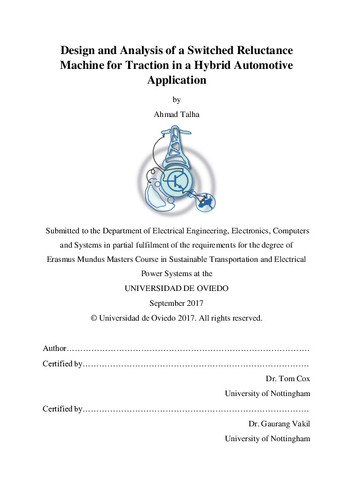Design and Analysis of a Switched Reluctance Machine for Traction in a Hybrid Automotive Application
Autor(es) y otros:
Director(es):
Fecha de publicación:
Serie:
Máster Universitario Erasmus Mundus en Transporte Sostenible y Sistemas Eléctricos de Potencia (EMMC STEPS)
Descripción física:
Resumen:
A switched reluctance machine (SRM) is very robust and capable to perform well under harsh conditions. It is simple in construction and avoids the use of magnets so it is cheap to manufacture. The powertrain of a hybrid vehicle presents challenging conditions for an electric machine. A SRM is a potentially strong contender for such applications. In this project, a 43 kW SRM is designed for a hybrid traction application. Three topologies: three-phase 6/4, three-phase 12/8 and 4-phase 8/6 machines are considered as possible design choices. The main design objectives are to satisfy the torque and efficiency requirements and a secondary objective is to minimise the torque ripple. A base design is developed for each topology under consideration. The base designs are improved by carefully focusing on the impact of all important machine geometrical parameters such as rotor diameter, pole arcs and stator back-iron thickness on torque and efficiency. One design topology is selected as the final design of choice for the application based on the simulated performance. Results show that SRM can meet torque and efficiency requirements. The efficiency increases with the speed so SRM is better suited to high speed traction application. The area of concern is the torque ripple as it increases with the speed and needs to be controlled both at the design and control stages
A switched reluctance machine (SRM) is very robust and capable to perform well under harsh conditions. It is simple in construction and avoids the use of magnets so it is cheap to manufacture. The powertrain of a hybrid vehicle presents challenging conditions for an electric machine. A SRM is a potentially strong contender for such applications. In this project, a 43 kW SRM is designed for a hybrid traction application. Three topologies: three-phase 6/4, three-phase 12/8 and 4-phase 8/6 machines are considered as possible design choices. The main design objectives are to satisfy the torque and efficiency requirements and a secondary objective is to minimise the torque ripple. A base design is developed for each topology under consideration. The base designs are improved by carefully focusing on the impact of all important machine geometrical parameters such as rotor diameter, pole arcs and stator back-iron thickness on torque and efficiency. One design topology is selected as the final design of choice for the application based on the simulated performance. Results show that SRM can meet torque and efficiency requirements. The efficiency increases with the speed so SRM is better suited to high speed traction application. The area of concern is the torque ripple as it increases with the speed and needs to be controlled both at the design and control stages
Colecciones
- Trabajos Fin de Máster [5296]
Ficheros en el ítem




